5 建立基础模型,尝试多种算法
#之前把精力都放在了前面了,这回我的重点就要放在建模上了,导入所需要的包 # 数据分析库 import pandas as pd import numpy as np # warnings:警告——>忽视 pd.options.mode.chained_assignment = None pd.set_option('display.max_columns', 60) # 可视化 import matplotlib.pyplot as plt %matplotlib inline # 字体大小设置 plt.rcParams['font.size'] = 24 from IPython.core.pylabtools import figsize # Seaborn 高级可视化工具 import seaborn as sns sns.set(font_scale = 2) # 预处理:缺失值 、 最大最小归一化 from sklearn.preprocessing import Imputer, MinMaxScaler # 机器学习算法库 from sklearn.linear_model import LinearRegression from sklearn.ensemble import RandomForestRegressor, GradientBoostingRegressor from sklearn.svm import SVR from sklearn.neighbors import KNeighborsRegressor # 调参工具包 from sklearn.model_selection import RandomizedSearchCV, GridSearchCV import warnings warnings.filterwarnings("ignore")
- 上次保存好的数据加载进来
# Read in data into dataframes train_features = pd.read_csv('data/training_features.csv') test_features = pd.read_csv('data/testing_features.csv') train_labels = pd.read_csv('data/training_labels.csv') test_labels = pd.read_csv('data/testing_labels.csv') # Display sizes of data print('Training Feature Size: ', train_features.shape) print('Testing Feature Size: ', test_features.shape) print('Training Labels Size: ', train_labels.shape) print('Testing Labels Size: ', test_labels.shape)
Training Feature Size: (6622, 67) Testing Feature Size: (2839, 67) Training Labels Size: (6622, 1) Testing Labels Size: (2839, 1)
train_features.head()
5.1 缺失值填充

imputer = Imputer(strategy='median') # 因为数据有离群点,有大有小,用mean不太合适,用中位数较合适 # 在训练特征中训练 imputer.fit(train_features) # 对训练数据进行转换 X = imputer.transform(train_features)#用中位数来代替做成的训练集 X_test = imputer.transform(test_features) #用中位数来代替做成的测试集
#np.isnan:数值进行空值检测 print('Missing values in training features: ', np.sum(np.isnan(X))) #返回的是0 ,代表缺失值任务已经完成了 print('Missing values in testing features: ', np.sum(np.isnan(X_test)))
Missing values in training features: 0 Missing values in testing features: 0
5.2 特征进行与归一化
scaler = MinMaxScaler(feature_range=(0, 1)) # 训练与转换 scaler.fit(X) # 把训练数据转换过来(0,1) X = scaler.transform(X) X_test = scaler.transform(X_test) # 测试数据
#标签值是1列 ,reshape变成1行 # reshape(行数,列数)常用来更改数据的行列数目 y = np.array(train_labels).reshape((-1,))#一维数组 , 变成1列 y_test = np.array(test_labels).reshape((-1, )) # 一维数组 , 变成1列
6 建立基础模型,尝试多种算法(回归问题)
1. Linear Regression
2. Support Vector Machine Regression
3. Random Forest Regression
4. Gradient Boosting Regression
5. K-Nearest Neighbors Regression6.1 建立损失函数

# 在这里的损失函数是MAE ,abs()是绝对值 def mae(y_true, y_pred): return np.mean(abs(y_true - y_pred)) #制作一个模型 ,训练模型和在验证集上验证模型的参数 def fit_and_evaluate(model): # 训练模型 model.fit(X, y) # 训练模型开始在测试数据上训练 model_pred = model.predict(X_test) model_mae = mae(y_test, model_pred) return model_mae
6.2 选择机器学习算法

lr = LinearRegression()#线性回归 lr_mae = fit_and_evaluate(lr) print('Linear Regression Performance on the test set: MAE = %0.4f' % lr_mae)
Linear Regression Performance on the test set: MAE = 12.9817
svm = SVR(C = 1000, gamma = 0.1) #支持向量机 svm_mae = fit_and_evaluate(svm) print('Support Vector Machine Regression Performance on the test set: MAE = %0.4f' % svm_mae)
Support Vector Machine Regression Performance on the test set: MAE = 10.9336
random_forest = RandomForestRegressor(random_state=60)#集成算法的随机森林 random_forest_mae = fit_and_evaluate(random_forest) print('Random Forest Regression Performance on the test set: MAE = %0.4f' % random_forest_mae)
Random Forest Regression Performance on the test set: MAE = 10.0941
gradient_boosted = GradientBoostingRegressor(random_state=60) #梯度提升树 gradient_boosted_mae = fit_and_evaluate(gradient_boosted) print('Gradient Boosted Regression Performance on the test set: MAE = %0.4f' % gradient_boosted_mae)
Gradient Boosted Regression Performance on the test set: MAE = 9.9893
knn = KNeighborsRegressor(n_neighbors=10)#K近邻算法 knn_mae = fit_and_evaluate(knn) print('K-Nearest Neighbors Regression Performance on the test set: MAE = %0.4f' % knn_mae)
K-Nearest Neighbors Regression Performance on the test set: MAE = 12.6722
plt.style.use('fivethirtyeight') figsize(8, 6) model_comparison = pd.DataFrame({'model': ['Linear Regression', 'Support Vector Machine', 'Random Forest', 'Gradient Boosted', 'K-Nearest Neighbors'], 'mae': [lr_mae, svm_mae, random_forest_mae, gradient_boosted_mae, knn_mae]}) # ascending=True是对的意思升序 降序 :从大到小/从第1行到第5行 barh:横着去画的直方图 model_comparison.sort_values('mae', ascending = False).plot(x = 'model', y = 'mae', kind = 'barh', color = 'red', edgecolor = 'black') # 纵轴是算法模型的名称 yticks:为递增值向量 横轴是MAE损失 xticks:为递增值向量 plt.ylabel(''); plt.yticks(size = 14); plt.xlabel('Mean Absolute Error'); plt.xticks(size = 14) plt.title('Model Comparison on Test MAE', size = 20);
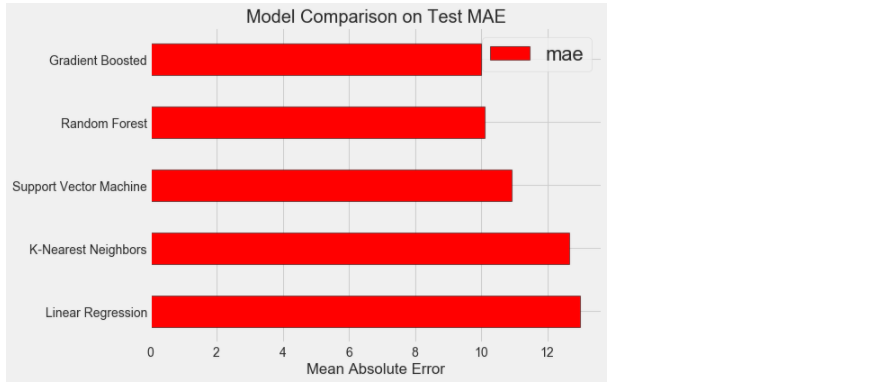
7 模型调参
7.1 调参
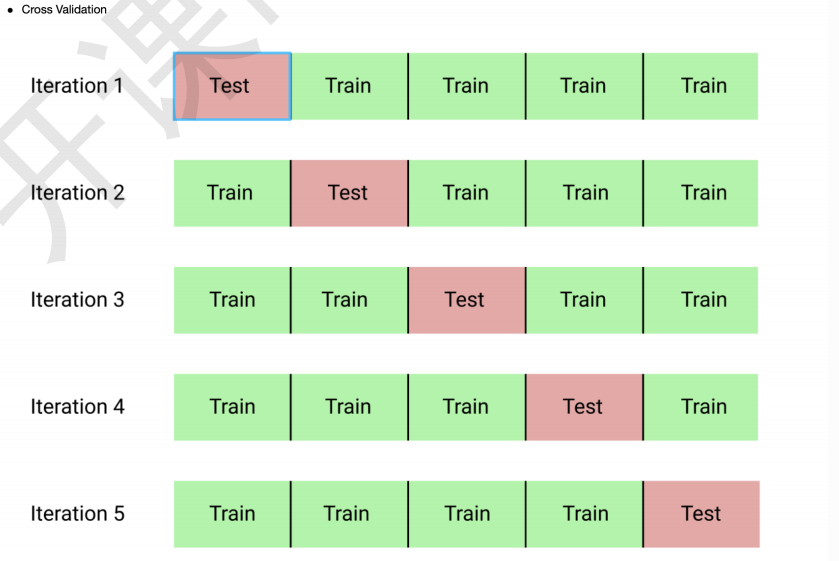

loss = ['ls', 'lad', 'huber'] # 所使用的弱“学习者”(决策树)的数量 n_estimators = [100, 500, 900, 1100, 1500] # 决策树的最大深度 max_depth = [2, 3, 5, 10, 15] # 决策树的叶节点所需的最小示例个数 min_samples_leaf = [1, 2, 4, 6, 8] # 分割决策树节点所需的最小示例个数 min_samples_split = [2, 4, 6, 10] hyperparameter_grid = {'loss': loss, 'n_estimators': n_estimators, 'max_depth': max_depth, 'min_samples_leaf': min_samples_leaf, 'min_samples_split': min_samples_split}

model = GradientBoostingRegressor(random_state = 42) random_cv = RandomizedSearchCV(estimator=model, param_distributions=hyperparameter_grid, cv=4, n_iter=25, scoring = 'neg_mean_absolute_error', #选择好结果的评估值 n_jobs = -1, verbose = 1, return_train_score = True, random_state=42)
# 注意:运行的时间非常慢,需要14mins random_cv.fit(X, y)
RandomizedSearchCV(cv=4, error_score='raise-deprecating', estimator=GradientBoostingRegressor(alpha=0.9, criterion='friedman_mse', init=None, learning_rate=0.1, loss='ls', max_depth=3, max_features=None, max_leaf_nodes=None, min_impurity_decrease=0.0, min_impurity_split=None, min_samples_leaf=1, min_samples_split=2, min_weight_fraction_leaf=0.0, n_estimators=100,... verbose=0, warm_start=False), iid='warn', n_iter=25, n_jobs=-1, param_distributions={'loss': ['ls', 'lad', 'huber'], 'max_depth': [2, 3, 5, 10, 15], 'min_samples_leaf': [1, 2, 4, 6, 8], 'min_samples_split': [2, 4, 6, 10], 'n_estimators': [100, 500, 900, 1100, 1500]}, pre_dispatch='2*n_jobs', random_state=42, refit=True, return_train_score=True, scoring='neg_mean_absolute_error', verbose=1)
random_cv.best_estimator_ #最好的参数
输出:GradientBoostingRegressor(alpha=0.9, criterion='friedman_mse', init=None,
learning_rate=0.1, loss='lad', max_depth=5,
max_features=None, max_leaf_nodes=None,
min_impurity_decrease=0.0, min_impurity_split=None,
min_samples_leaf=4, min_samples_split=2,
min_weight_fraction_leaf=0.0, n_estimators=500,
n_iter_no_change=None, presort='auto',
random_state=42, subsample=1.0, tol=0.0001,
validation_fraction=0.1, verbose=0, warm_start=False)

# 创建树策个数 trees_grid = {'n_estimators': [100, 150, 200, 250, 300, 350, 400, 450, 500, 550, 600, 650, 700, 750, 800]} #建立模型 #lad:最小化绝对偏差 model = GradientBoostingRegressor(loss = 'lad', max_depth = 5, min_samples_leaf = 6, min_samples_split = 6, max_features = None, random_state = 42) # 传入参数 grid_search = GridSearchCV(estimator = model, param_grid=trees_grid, cv = 4, scoring = 'neg_mean_absolute_error', verbose = 1, n_jobs = -1, return_train_score = True)
# 需要3mins grid_search.fit(X, y)
输出:
GridSearchCV(cv=4, error_score='raise-deprecating', estimator=GradientBoostingRegressor(alpha=0.9, criterion='friedman_mse', init=None, learning_rate=0.1, loss='lad', max_depth=5, max_features=None, max_leaf_nodes=None, min_impurity_decrease=0.0, min_impurity_split=None, min_samples_leaf=6, min_samples_split=6, min_weight_fraction_leaf=0.0, n_estimators=100, n_iter_no_change=None, presort='auto', random_state=42, subsample=1.0, tol=0.0001, validation_fraction=0.1, verbose=0, warm_start=False), iid='warn', n_jobs=-1, param_grid={'n_estimators': [100, 150, 200, 250, 300, 350, 400, 450, 500, 550, 600, 650, 700, 750, 800]}, pre_dispatch='2*n_jobs', refit=True, return_train_score=True, scoring='neg_mean_absolute_error', verbose=1)
7.2 对比损失函数

# 得到结果传入DataFrame results = pd.DataFrame(grid_search.cv_results_) # 画图操作 figsize(8, 8) plt.style.use('fivethirtyeight') plt.plot(results['param_n_estimators'], -1 * results['mean_test_score'], label = 'Testing Error') plt.plot(results['param_n_estimators'], -1 * results['mean_train_score'], label = 'Training Error') #横轴是树的个数 ,纵轴是MAE的误差 plt.xlabel('Number of Trees'); plt.ylabel('Mean Abosolute Error'); plt.legend(); plt.title('Performance vs Number of Trees'); #过拟合 , 蓝色平缓 ,红色比较陡 ,中间的数据越来陡,所以overfiting
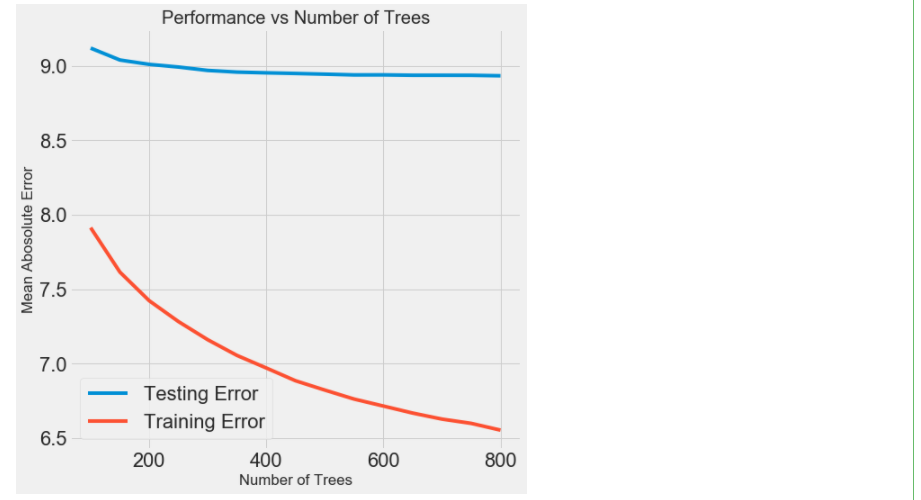
8 评估与测试:预测和真实之间的差异图
# 测试模型 default_model = GradientBoostingRegressor(random_state = 42) default_model.fit(X,y) # 选择最好的参数 final_model = grid_search.best_estimator_ final_model
输出:
GradientBoostingRegressor(alpha=0.9, criterion='friedman_mse', init=None,
learning_rate=0.1, loss='lad', max_depth=5,
max_features=None, max_leaf_nodes=None,
min_impurity_decrease=0.0, min_impurity_split=None,
min_samples_leaf=6, min_samples_split=6,
min_weight_fraction_leaf=0.0, n_estimators=800,
n_iter_no_change=None, presort='auto',
random_state=42, subsample=1.0, tol=0.0001,
validation_fraction=0.1, verbose=0, warm_start=False)
default_pred = default_model.predict(X_test) final_pred = final_model.predict(X_test) print('Default model performance on the test set: MAE = %0.4f.' % mae(y_test, default_pred)) print('Final model performance on the test set: MAE = %0.4f.' % mae(y_test, final_pred))
Default model performance on the test set: MAE = 9.9864. Final model performance on the test set: MAE = 9.1172.
Default model performance on the test set: MAE = 9.9864.
Final model performance on the test set: MAE = 9.1172.

figsize = (6, 6) # 最终的模型差异 = 模型 - 测试值 ,大部分都在+-25% residuals = final_pred - y_test plt.hist(residuals, color = 'red', bins = 20, edgecolor = 'black') plt.xlabel('Error'); plt.ylabel('Count') plt.title('Distribution of Residuals');


9 解释模型:基于重要性来进行特征选择
import pandas as pd import numpy as np pd.options.mode.chained_assignment = None pd.set_option('display.max_columns', 60) import matplotlib.pyplot as plt %matplotlib inline plt.rcParams['font.size'] = 24 from IPython.core.pylabtools import figsize import seaborn as sns sns.set(font_scale = 2) from sklearn.preprocessing import Imputer, MinMaxScaler from sklearn.linear_model import LinearRegression from sklearn.ensemble import GradientBoostingRegressor from sklearn import tree import warnings warnings.filterwarnings("ignore")
- 先拿到我们上个模型的结果
train_features = pd.read_csv('data/training_features.csv') test_features = pd.read_csv('data/testing_features.csv') train_labels = pd.read_csv('data/training_labels.csv') test_labels = pd.read_csv('data/testing_labels.csv')
# 用中值代替缺失值 imputer = Imputer(strategy='median') # 开始训练 imputer.fit(train_features) X = imputer.transform(train_features) X_test = imputer.transform(test_features) y = np.array(train_labels).reshape((-1,)) y_test = np.array(test_labels).reshape((-1,))
def mae(y_true, y_pred): return np.mean(abs(y_true - y_pred))
model = GradientBoostingRegressor(loss='lad', max_depth=5, max_features=None, min_samples_leaf=6, min_samples_split=6, n_estimators=800, random_state=42) model.fit(X, y)
输出:
GradientBoostingRegressor(alpha=0.9, criterion='friedman_mse', init=None,
learning_rate=0.1, loss='lad', max_depth=5,
max_features=None, max_leaf_nodes=None,
min_impurity_decrease=0.0, min_impurity_split=None,
min_samples_leaf=6, min_samples_split=6,
min_weight_fraction_leaf=0.0, n_estimators=800,
n_iter_no_change=None, presort='auto',
random_state=42, subsample=1.0, tol=0.0001,
validation_fraction=0.1, verbose=0, warm_start=False)
# GBDT模型作为最终的模型 model_pred = model.predict(X_test) print('Final Model Performance on the test set: MAE = %0.4f' % mae(y_test, model_pred))
Final Model Performance on the test set: MAE = 9.1485
# 特征重要度 feature_results = pd.DataFrame({'feature': list(train_features.columns), #所有的训练特征 'importance': model.feature_importances_}) # 展示前10名的重要的特征 ,降序 feature_results = feature_results.sort_values('importance', ascending = False).reset_index(drop=True) feature_results.head(10)
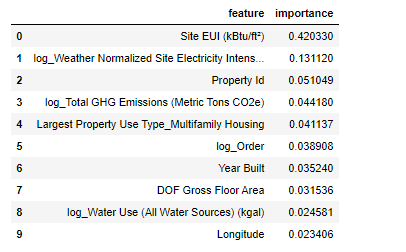
figsize(12, 10) plt.style.use('fivethirtyeight') # 展示前10名的重要的特征 feature_results.loc[:9, :].plot(x = 'feature', y = 'importance', edgecolor = 'k', kind='barh', color = 'blue');#barh:直方图横着 plt.xlabel('Relative Importance', size = 20); plt.ylabel('') plt.title('Feature Importances from Random Forest', size = 30);
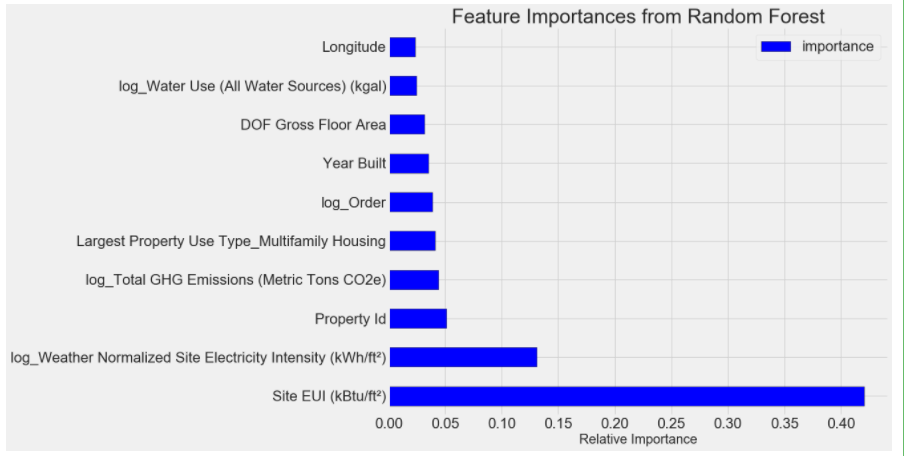
most_important_features = feature_results['feature'][:10]#前10行的特征 # indices=10个列名 indices = [list(train_features.columns).index(x) for x in most_important_features]# 列表推导式 X_reduced = X[:, indices] X_test_reduced = X_test[:, indices] print('Most important training features shape: ', X_reduced.shape) print('Most important testing features shape: ', X_test_reduced.shape)
Most important training features shape: (6622, 10) Most important testing features shape: (2839, 10)
lr = LinearRegression() lr.fit(X, y) lr_full_pred = lr.predict(X_test) lr.fit(X_reduced, y) lr_reduced_pred = lr.predict(X_test_reduced) print('Linear Regression Full Results: MAE = %0.4f.' % mae(y_test, lr_full_pred)) print('Linear Regression Reduced Results: MAE = %0.4f.' % mae(y_test, lr_reduced_pred))
Linear Regression Full Results: MAE = 12.9817. Linear Regression Reduced Results: MAE = 14.4826.
